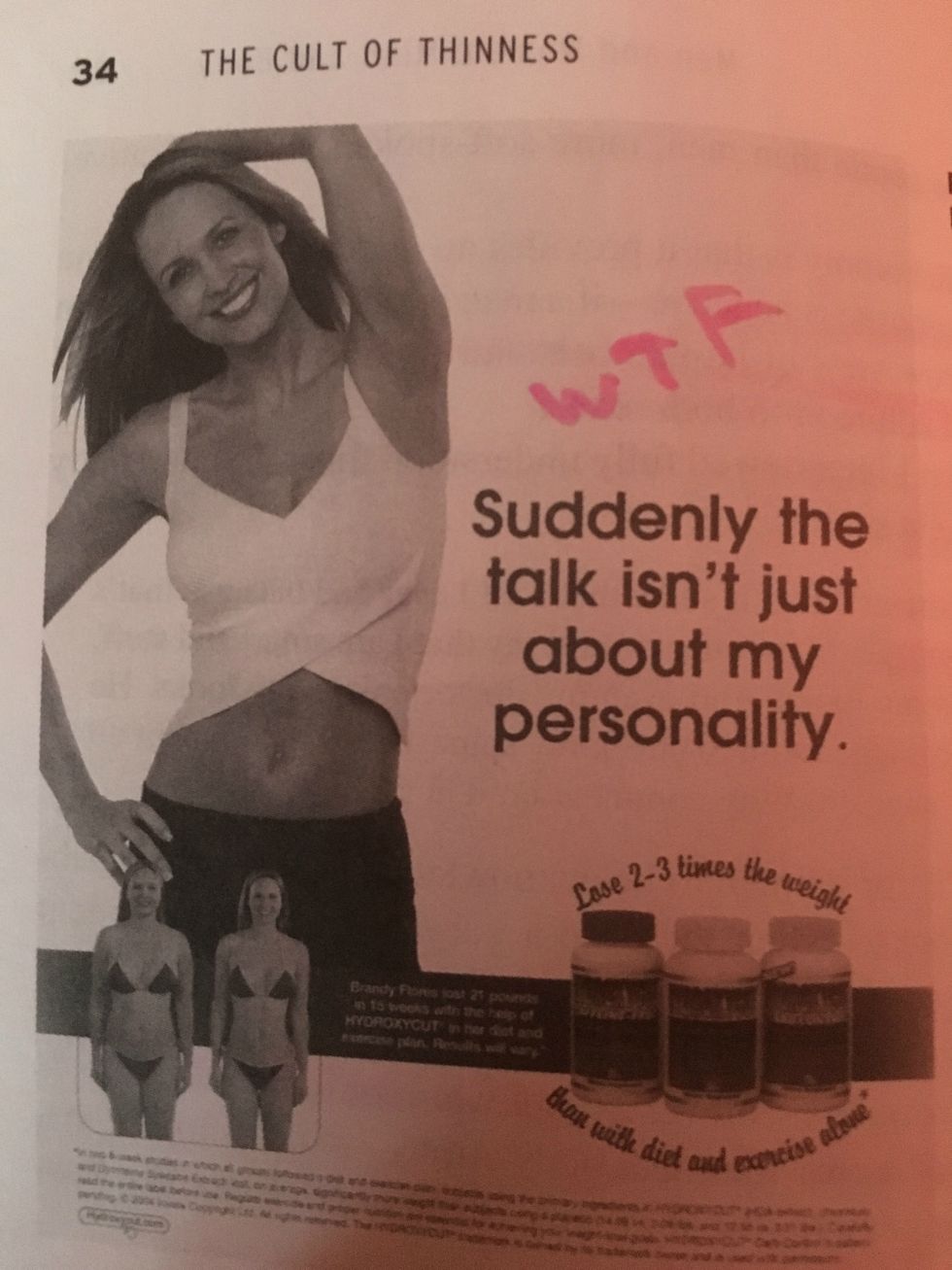I consider myself conditioned. I know the size of any dress before I look at the tag, and I’m well aware that you can only work as a Disney Princess at sizes 4, 6, 8. I catch myself supposing the dress sizes of dancers in a kick line: 2, 0, 2, 4, 0, 2, 2... then there is me: 12 sometimes, 14 most times — and if I’m lucky, I can fit into a 10. I used to be 6, and then college started.
According to most size charts in America, sizes vary by two numbers either way. Small is usually considered 4-6, medium 8-10, large 12-14, X-large 16-18...so on. The issue for me, and for many others, is that there is an artificial binary added to the already distressing system. There is a line for women (and men) that, when crossed, splits you into a separate category of body — a different type of human, so much so that some places like Hollister and Lululemon refuse to cater to.
According to Teen People in August 2005: “53% of girls believe they weigh too much...” Over half of female-identified human beings are having their lives degraded by paradigms they hardly have a say in.
Despite the American woman’s average size being a technical “large,” it doesn’t make much economic sense to focus on smaller clothing while ostracizing larger sizes. However, it makes sense a lot of sense culturally.
In Sharlene Nagy Hesse-Biber’s book "The Cult Of Thinness," this phenomenon is explained. Notice how the terminology shifts from one gender to the other. For sizes above 12, women are considered “plus-sized.” For men, their version of plus-size is called “big and tall.” Hesse Bieber explains:
“Our culture judges a man in terms of how powerful, aggressive, and dominant he is in the worlds of thought and action...on the other hand, a woman is judged almost entirely in terms of her appearance, her attractiveness to these men — and the ability to keep her species going...the split between mind and body...ignores the reality that there are a range of behavior and traits common and practical for both sexes...”
In summation, to be “big and tall” as a man is a generally accepted category to be in. However, the term “plus-sized” for women suggests that their being is an extra — unneeded — supplementary to the ideal form that the media pushes onto us. While plus-sized clothing is still smaller than the male “regular” line, we are conditioned to believe that once we have crossed the “plus-size” line, we have entered into treacherous waters — and it is advised we lose weight in order to fall back below the number line.
Biber comments on the shift between the 1900s and the 1920s: where the “boyish” flapper frame became desirable:
“Just as women were demanding more space and equality, the cultural standards of attractiveness demanded they shrink...these activities continue to divert economic and emotional capital away from investments women might make like political activism, education, and careers.”
Yes, it is important to live a healthy lifestyle, exercise, and eat moderately — however, the idea of fitness for the mind and body is different for each person. When someone else assumes a person's health based on their relative size and chooses to condemn them for it, it is thinly veiled fatphobia. The angry way we feel about ourselves is cultural fatphobia ingrained in our brains, slowly weaving our body dysmorphia to our eating behavior. If this culture of cruelty is allowed to continue, then we as a country will continue to suffer. Having fat does not mean you aren’t healthy, and being thin isn’t indicative of health either. It really is how you feel that determines your health.
If you don’t believe Biber, maybe some Aristotle will convince you of the glaring cultural dichotomy forged by the sexes. Aristotle, who influenced Christian doctrine, suggested women were
“monsters deviated from the generic human type... imperfect versions of the ideal form (men), who were emotional and passive prisoners of the bodies function thus incapable of reason.”
Given these cultural ideas, it is no surprise women feel swells of shame, pressure, and ostracization based on their physical size and shape. It doesn’t have to be that way, and many people are starting to agree.
I think women should be allowed to take up as much space as a man without being martyred for it. For example, when Ashley Graham graced the cover of Sports Illustrated, an uproar ensued. Many were pleased that the first “plus-sized” model got the gig, others disgusted they would allow a “plus” girl on their prestigious pages. In my mind, it shouldn’t be a matter of plus-sized or not, it should be about Ashley’s beauty and identity — not contingent on her being plus-sized or not.
In the world of modeling, sizes are smaller and end sooner. To be a size 6 or above in the modeling world is to be “plus-sized.” This suggests corporate interest and the idea of beauty are being molded by the men in charge of the industry. Directors, dressers, designers — especially in the entertainment industry — have a similar set of ideas, and those ideals are made reality by the types of bodies we see on screen and on paper. This unrealistic standard promotes hatred of the perceived embodiment of gluttony.
Women fear being called fat more than anything. There is a valid and palpable tension surrounding the size and space people take up, especially women who are and have been considered ornamental above all for very long time. Even in the Bible, it suggests a woman’s place is to be seen, not heard. For as long as history is recorded, women have been pressured if not forced to fit a mold and punished when they take up too much space.
We can work past this conditioning with awareness, empathy, and willingness to change. The cultural idea of beauty and health are warped and cause real psychological and psychical damage. We have an obesity epidemic as well as an eating disorder epidemic in this country because society is acting as a rubber band: snapping back, circling around the same ideas of shame, pride, envy, gluttony, and sloth. We can start by using the word 'fat' for what it is: tissue. Fat isn’t who you are, it is what you have — and with diligence, we can split that idea from our identities.




















